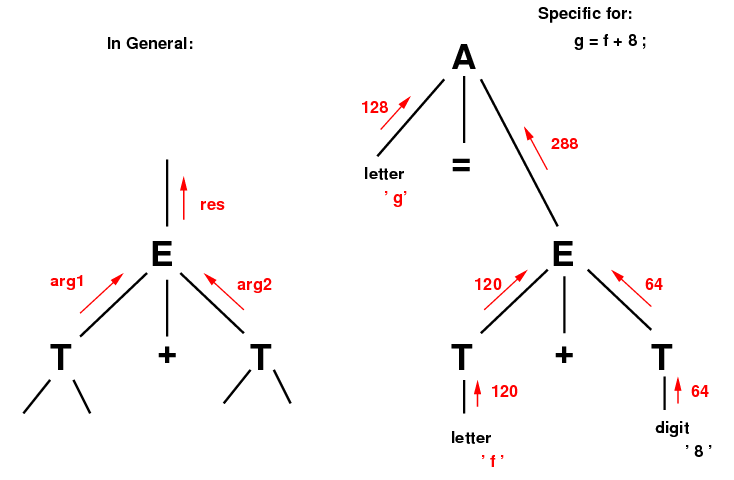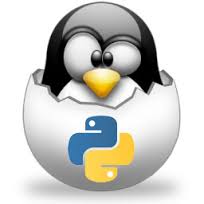|
CS 3721 Programming Languages Spring 2014 | |
Recitation 5.
Assignments
| ||
Week 5: Feb 11 - 13
| ||
Submit following directions at:
submissions
and rules at:
rules.
Deadlines are:
|
Compiler for Assignments, and for I/O: Study the pages:
- Recursive-Descent Parsing:
- R-D Parsers (Parsers: "Bare", Debug)
- Evaluate double Expression: C Version, Java Version.
- Tiny® Language:
- MIPS Assembly Language:
Overview: For this recitation you are to do the following:
- A. Write an R-D parser for a subset of Tiny.
- B. Add Code to make the program into a compiler.
- C. Compile 4 Tiny programs to MIPS and run the MIPS with SPIM.
A. Write an R-D Parser for a subset of Tiny:
- Write a program in Java or C that
will parse the following grammar, which is a subset of
the full language we want to compile:
| Subset Tiny® Grammar |
|---|
M −−> S { S } '$'
S −−> A | P | G
A −−> lower-case '=' E ';'
P −−> '<' E ';' | '<' ('B' | 'N' | 'T') ';'
G −−> '>' lower-case ';'
E −−> T {('+' | '-') T}
T −−> F {('*' | '/') F}
F −−> '(' E ')' | lower-case | digit
|
| Features Implemented by this Recitation | ||
|---|---|---|
| Name of Feature | Grammar Rule | Tiny Examples |
| Assignment Statement (Insert value into a variable) | A −−> lower-case '=' E ';' |
n = n + 1; a = 2*b/c-4; |
| Output Expression (Output value of an expression) |
P −−> '<' E ';' |
< n; < (a+b)/2; |
| Output Blank, Newline, or Tab (B for ' ', N for '\n', T for '\t') |
P −−> '<' ('B' | 'N' | 'T') ';' |
< B; < N; < T; |
| Input Value (Insert value from input into a variable) |
G −−> '>' lower-case ';' |
> n; > a; > p; |
B. Add Code to Make the program into a compiler:
- If F handles a digit, say stored in a variable ch, then F should return (ch-'0') (or this times 8).
- If F handles a lower-case letter, stored in ch, then F should return (ch-'a'+10) (or this times 8).
- If F handles an expression (in parens) by calling E, the F should return whatever E returns (will already be multiplied by 8, if that is the way you are handling things).
- Change F so that it returns the proper integer for a lower-case letter and the proper one for a digit.
- Change T and E so that they pass the value coming to them from below on up by returning it.
- Add code to A so that it completely handles an assignment.
A first decides which address belongs
to the variable on the left side. Save this number inside A.
Then get the number returned from a call to E.
Multiply this by 8 to get byte offset of the expression from
the start of M. (Or you may be working with addresses that are
already multiplied by 8.)
Finally generate (print) two MIPS
instructions, the first to load the number at the locations
returned by E into a register, and second to store
this number into the location given by the identifier at
the right side of the assignment. So
start with the input: f = 7;$, which should be a legal
input to your parser. With the changes above, your program
should output the two MIPS instructions at the far left.
Then with the same program, try the second input.
Sample Input a: Input: f = 7; $ Should produce output: # M[15] = M[7] l.d $f2, 56($s1) s.d $f2, 120($s1)Sample Input b: Input: f = 7; g = f; $ Should produce output: # M[15] = M[7] l.d $f2, 56($s1) s.d $f2, 120($s1) # M[16] = M[15] l.d $f2, 120($s1) s.d $f2, 128($s1) - Start on the case of handling an
arithmetic operator in an expression.
This is by far the most difficult part, yet in the end it
doesn't take much coding.
Do just plus(+) first,
and focus on the following example.
(Once you have + done, the other three operators are essentially
the same.)
Sample Input c: Input: g = f + 8 ; $ Should produce output: # M[36] = M[15] + M[8] l.d $f2, 120($s1) l.d $f4, 64($s1) add.d $f6, $f2, $f4 s.d $f6, 288($s1) # M[16] = M[36] l.d $f2, 288($s1) s.d $f2, 128($s1)
How is Memory Mapped: We need to be clear about the use of memory at run time. Recall the .data part of the MIPS code we will use:
| MIPS Memory Allocation | ||
|---|---|---|
.data
.align 3
M: .double 0.,1.,2.,3.,4.,5.,6.
.double 7.,8.,9. # constants
.space 208 # variables a to z
.space 1000 # 125 temporaries
Blank: .asciiz " "
NewL: .asciiz "\n"
Tab: .asciiz "\t"
| ||
Returning Addresses: Start with your Tiny Parser from Part A above. Each function related to expressions will be returning an address where the value of the corresponding part of the program can be found at run time. Thus functions E, T, and F will each return such an address. In my own code I return the proper index of the M "array", and then multiply by 8 before using it, but you could instead return the actual address. For example, in your code, whenever you have a call to E, this call should return the address where the value of that expression will be at run time. It doesn't matter whether that call to E processes a digit, an identifier, or an arbitrarily complex expression. Consider what the function F should return in your code.
How To Get Started. I would start with the parser from Part A above. Then initially I would make only a few changes:
More about handling an addition: An addition was discussed and illustrated in Step 4 directly above. Let's go into it in more detail. Simplify the parser code so that it will just handle a single addition, without worrying about several of them. This is the function on the left below. The code beside on the right shows E returning an int to hold an address, the offset from $s1.
|
|

Very important: In problem 3 of Recitation 3, you translated something like f = g + 5; into 4 MIPS instructions. This was possible because you were looking at the entire statement at once. Your compiler will need 6 statements (as shown above) to translate this. The function E only handles expressions and addition/subtraction. It is completely separate from the function A that handles assignments. E doesn't know where its results are headed, and similarly, A doesn't know where the expression to the right of the assignment operator came from, or anything about this expression. As far as A knows, it could be a single variable, a single constant, or a very complex expression.
C. Compile 4 Tiny programs to MIPS and run the MIPS with SPIM.
- Give the complete Java or C source code for your compiler program.
- For each of the four sample program in turn, include:
- The original Tiny program.
- The complete MIPS code that results from compiling that Tiny program, for Sample Inputs 0 and 3 only. (My MIPS code for Sample Inputs 1 and 2 are 240 and 180 lines long respectively.)
- The output resulting from running that particular MIPS program using spim.
Sample Programs: (In the end, the three inputs above, a, b, and c, are for your own debugging.) Here are sample programs that you should compile from Tiny to MIPS assembly code. You then should execute the MIPS code. For these you need to implement the two types of output In order to successfully execute these using spim, you must add the stuff at the beginning and end of the complete sample programs. Of course all four programs work with doubles, but the doubles in Sample Input 1 are all exact integers.
|
|
|
|
What you should submit:
Revision date: 2014-01-29. (Use ISO 8601, an International Standard.)
